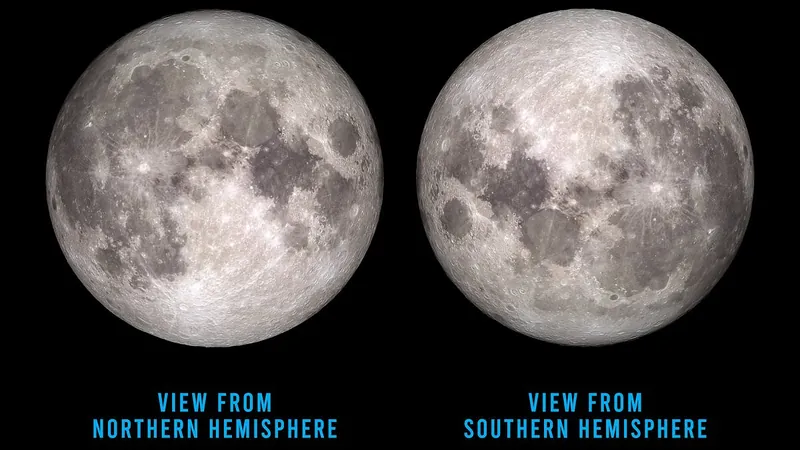
The Moon's Mysterious Appearance: Why Your Friends in Other Countries See It Differently!
2025-01-16
Author: Ting
The Moon's Mysterious Appearance: Why Your Friends in Other Countries See It Differently!
Have you ever looked up at the night sky and felt a strange connection to those across the globe? It’s a comforting thought that we’re all gazing at the same moon, right? Well, brace yourselves – it turns out that may not be the case at all!
Recent discussions on social media, sparked by a viral TikTok video, reveal that the moon appears drastically different depending on whether you’re in the Northern or Southern Hemisphere. Instead of viewing the moon as a uniform celestial body, perspectives shift significantly when crossing the equator.
A TikTok user named Corey captured this realization in his video, expressing disbelief that this fact isn’t taught in schools. "Why is this not common knowledge?" he lamented, referring to how the moon appears 'upside down' for those in the Southern Hemisphere compared to the Northern Hemisphere. For instance, when someone in Australia looks up at the moon, it's oriented differently than how it appears to a person in the UK.
The reactions online have been a mix of shock and confusion, with users expressing how this revelation has unsettled them. “Logically it checks out but emotionally, I’m deeply upset!” one commenter stated. Others were equally puzzled, with some admitting that they had lived in both hemispheres and had never realized the moon could appear so differently.
But why does this happen? The phenomenon is simply a result of our planet being a sphere. When you’re in the Southern Hemisphere, you need to look north to see the moon, while in the Northern Hemisphere, you gaze south. The moon itself doesn’t flip; it’s our position on Earth that changes our perspective.
It gets even more fascinating! Not only does the moon look different, but many aspects of celestial navigation are affected by your hemisphere. In the Northern Hemisphere, for instance, the darker regions of the moon are typically observed on the left side, while in the Southern Hemisphere, they appear on the right.
Further unraveling the mysteries of our skies, users discovered that the moon is not the only celestial body affected. One pointed out the curious fact that the patterns of constellations also flip depending on your location. “Did you know that water swirls in opposite directions depending on where you are?” another user quipped, linking their newfound lunar knowledge to the bizarre realities of Earth’s physics.
Interestingly, the moon's appearance from the equator is a enigma in itself. As you move closer to the equator, the moon rises in the east and sets in the west, but it rotates a full 180 degrees relative to the horizon throughout the night! This means that what you see when it rises can look considerably different from when it sets.
In a blog post from The Planetary Society, public education expert Kate Howells explains that this change in orientation is subtle. "When you travel a bit from the equator, the moon still rises and sets fairly consistently, but as you venture farther north or south, you will notice a distinct shift in its appearance."
So, whether you’re in Brazil, New Zealand, or just a road trip south from where you currently reside, remember: the moon holds secrets that can surprise even the most seasoned sky-gazers. And next time you look up, consider what your friends across the globe might be seeing—it’s not just a different time zone; it’s a whole new view of the same celestial body!
Curious about the night sky? Don’t forget to share this revelation with your friends and spark some intriguing conversations about how we all view our celestial neighbor!



 Brasil (PT)
Brasil (PT)
 Canada (EN)
Canada (EN)
 Chile (ES)
Chile (ES)
 Česko (CS)
Česko (CS)
 대한민국 (KO)
대한민국 (KO)
 España (ES)
España (ES)
 France (FR)
France (FR)
 Hong Kong (EN)
Hong Kong (EN)
 Italia (IT)
Italia (IT)
 日本 (JA)
日本 (JA)
 Magyarország (HU)
Magyarország (HU)
 Norge (NO)
Norge (NO)
 Polska (PL)
Polska (PL)
 Schweiz (DE)
Schweiz (DE)
 Singapore (EN)
Singapore (EN)
 Sverige (SV)
Sverige (SV)
 Suomi (FI)
Suomi (FI)
 Türkiye (TR)
Türkiye (TR)
 الإمارات العربية المتحدة (AR)
الإمارات العربية المتحدة (AR)